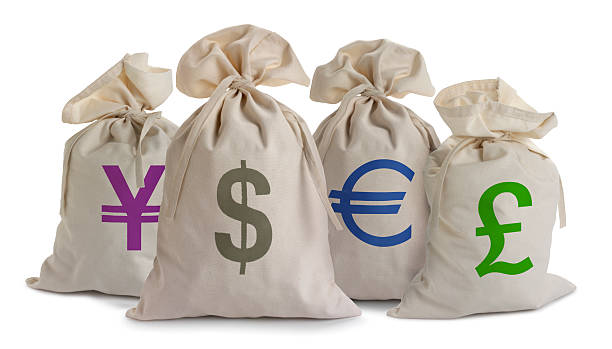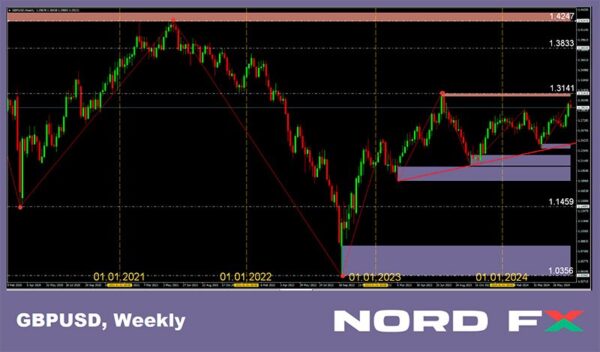News
Forex and Cryptocurrency Forecast – Action Forex

EUR/USD: FOMC – Are Surprises Expected on 31 July?
This review will begin somewhat unusually, not from the start, but from the end of the past work week. On the evening of 18 July and the morning of the 19th, system administrators and users encountered non-functional servers and PCs running Windows. These systems began displaying the “blue screen of death” (BSOD) and entered an endless reboot loop. This global Microsoft outage affected many countries, including the USA, the UK, Spain, Germany, Turkey, and Australia. Many users in China also experienced the “blue screens of death.” Critical computer systems, including those of emergency services, hospitals, police, airports, railways, broadcasters, internet providers, telecom companies, and other organisations such as banks and exchanges, either ceased functioning or started malfunctioning. Consequently, the situation in financial markets at that moment became almost force majeure.
The cause of the outage was identified as a software update from cybersecurity firm CrowdStrike, which conflicted with a new Windows update released simultaneously. Microsoft stated that they had identified the problem and were taking easing steps. However, the duration of this work remains unclear.
Now let’s move on to the more “traditional” news of the week and discuss the chances of monetary policy easing. On Thursday, 18 July, the European Central Bank (ECB) held a meeting, and the day before, Eurostat published consumer inflation (CPI) data. According to the statistical office’s final assessment, annual inflation decreased to 2.5% last month from 2.6%, in line with market expectations. The core indicator, Core CPI, which excludes food and energy, remained at 2.9%. It’s worth noting that it had shown a downward trend for nine months (from August 2023 to April 2024), reaching 2.7%. However, in May, it accelerated to 2.9% and remained at that level in June. Another inflation indicator, the Producer Price Index (PPI), registered at -0.2% month-on-month (forecast -0.1%) and -4.2% year-on-year (forecast -4.1%).
Commenting on these figures, ECB President Christine Lagarde stated that the regulator had made progress on the path to disinflation, as key inflation indicators are “moving in the right direction.” However, she indicated that the ECB would not lower rates in July but did not rule out further steps towards monetary policy easing (QE) at the autumn meetings.
Of course, she knew what she was talking about: on the following day, at its meeting, the European Central Bank (ECB) kept the key interest rate unchanged at 4.25%. At the concluding press conference, Madam Lagarde did not say anything new. She pointed out the weakness of the European economy, noting that the risks to economic growth were leaning towards the downside. Regarding persistently high inflation, Ms. Lagarde reiterated that the ECB’s decisions remain data-dependent. While she did not signal an imminent easing of monetary policy, she stated that the decision on the rate at the Governing Council meeting on 12 September remains “open.”
The risk-averse market atmosphere and Christine Lagarde’s dovish and vague comments prevented EUR/USD from continuing its move towards 1.1000, sending it down to the 1.0900 zone. On Friday morning, ECB Governing Council member and President of the Bank of France, François Villeroy de Galhau, stated that uncertainty regarding economic growth had increased compared to a few months ago. He added that the market’s expectations regarding the ECB’s rate forecast were justified. His colleague on the Governing Council, the head of the Central Bank of Lithuania, Gediminas Simkus, also agreed with the market’s prediction of two more 25 basis points (bps) rate cuts by the end of 2024.
Such dovish sentiments from European officials could have exerted significant downward pressure on EUR/USD, but similar rhetoric is also coming from their counterparts across the Atlantic. The next FOMC (Federal Open Market Committee) meeting of the Federal Reserve is scheduled for Wednesday, 31 July. According to economists at Goldman Sachs, amid a sharp drop in U.S. inflation from 4.3% to 2.6%, the steepest decline since 1984, and a surge in unemployment from 3.6% to 4.1%, the regulator could begin gradually lowering the rate at this meeting. However, most FOMC officials, including Fed Chair Jerome Powell, assert that the time for easing monetary policy has not yet arrived and that it is necessary to wait for new data. They suggest that any changes could be discussed in September.
Currently, the probability of a rate cut for the dollar in September stands at 96%, while for the euro, it is slightly lower at 80% (considering the 25 bps cut that occurred in June).
So, if nothing happens on 31 July, the Fed rate will remain at 5.50%. Since the ECB rate is 4.25%, this gives a certain advantage to the American currency. If risk aversion continues to dominate the market, it will create additional pressure on EUR/USD.
The pair ended the past week at 1.0883. As of the evening of 19 July, the analysts’ forecast for the near term is as follows: 55% of their votes are for the pair’s rise, and 65% for its fall. In technical analysis, 80% of trend indicators still favour the euro, while 15% have switched to the dollar. Among oscillators, 85% are green, with 15% turning neutral. The nearest support for the pair is at the 1.0865 zone, followed by 1.0790-1.0805, 1.0725, 1.0665-1.0680, 1.0600-1.0620, 1.0565, 1.0495-1.0515, 1.0450, and 1.0370. Resistance zones are located around 1.0890-1.0915, 1.0945, 1.0980-1.1010, 1.1050, and 1.1100-1.1140.
In the upcoming week, data on retail sales volumes in Germany will be released on Monday, 22 July. Wednesday, 24 July, can be called PPI Day, as a stream of preliminary data on business activity in various sectors of the economies of Germany, the Eurozone, and the USA will be released. On Thursday, we will learn about the state of the American economy in Q2, with GDP figures for this period becoming available. Additionally, the traditional number of initial jobless claims in the United States will be published on this day. The last working day of the week is expected to be very volatile, as on Friday, 26 July, the USA will release the Core CPI inflation figures, which are a key reference for the Federal Reserve’s monetary policy decisions.
GBP/USD: Bank of England – Are Surprises Expected on 1 August?
Our previous review of GBP/USD was titled “Pound Wins with Labour,” and indeed, it has. Over the past week, the pair reached a high of 1.3043, rising to levels last seen a year ago in July 2023. In our view, this surge was driven more by political speculations surrounding the opposition’s rise to power and the change of government in the UK than by economic indicators. What this reshuffle will actually deliver remains to be seen and assessed. For now, it is merely an opportunity to profit from new Prime Minister Keir Starmer’s promises of a “national renewal.”
The current macroeconomic statistics for the United Kingdom, published over the past week, did not provide much cause for optimism. Inflation data released on Wednesday, 17 July, was slightly higher than expected. The headline CPI came in at 2.0% year-on-year (market expectations were 1.9%), and the core CPI reached 3.5% (forecast was 3.4%). Although these figures are close to forecasts, they show that UK inflation remains stubborn and is resisting the Bank of England’s (BoE) efforts.
On Friday, 19 July, the Office for National Statistics (ONS) published retail sales data for the UK, which also turned out to be disappointing. On a monthly basis, sales fell by -1.2% in June, following a rebound of 2.9% in May. Markets had predicted a decline of only -0.4%. The core retail sales indicator, excluding automotive fuel sales, fell by -1.5% month-on-month, compared to the previous jump of 2.9% and a forecast of -0.5%. The annual volume decreased by -0.2% in June, against a May growth of +1.3%, while the core figure declined by 0.8% year-on-year, compared to +1.2% the previous month.
In light of these data, the British currency began to lose ground, and GBP/USD ended the past week at 1.2912. Specialists at Singapore’s UOB Bank believe that “the upward momentum has significantly weakened, and the pair’s growth has come to an end.” In their opinion, “the pound has likely entered a consolidation phase and will trade between 1.2850 and 1.3020 for some time.”
Of course, much will depend on what happens at the BoE meeting on 1 August. The last rate change was a year ago, on 3 August 2023, when it was raised by 25 basis points to 5.25%. Now, according to analysts at Commerzbank, “the next Bank of England decision should be very interesting.” They write, “We still lean towards the Bank of England soon making its first rate cut. However, whether this happens in August or September, the key point is that with the persistently high levels of core inflation and inflation in the services sector, a significant rate cut is unlikely. Therefore, in the medium term, the pound sterling should continue to receive good support.”.
For now, the median forecast of experts for the near term is as follows: only 20% of analysts expect further strengthening of the pound and a rise in the pair, 60% predict a decline, and the remaining 20% have taken a neutral stance. As for the technical analysis on D1, 75% of trend indicators are green, and 25% are red. Among oscillators, 75% are green, 10% are neutral grey, and only 5% are red.
In the event of further declines, the pair will encounter support levels and zones at 1.2850-1.2860, followed by 1.2780-1.2800, 1.2610-1.2625, 1.2540, 1.2445-1.2465, 1.2405, and 1.2300-1.2330. In the case of a rise, resistance levels are expected at 1.2990-1.3005, followed by 1.3040, 1.3100-1.3140, 1.3265-1.3300, 1.3375, 1.3315, 1.3555-1.3640, and 1.3750.
The release of preliminary business activity (PPI) data for the UK economy on Wednesday, 24 July, stands out among the events of the upcoming week. No other significant macroeconomic data releases are expected in the coming days. The next important event, as previously mentioned, will be the Bank of England meeting on Thursday, 1 August.
USD/JPY: Bank of Japan – Are Surprises Expected on 31 July?
According to strategists from ING, USD/JPY “delivered a bundle of surprises this week, retreating to the 155/156 area.” Frankly, the surprise for us was not the yen’s strengthening, but these words from ING experts. After all, what’s so surprising about it? In our reviews, we have repeatedly warned about possible currency interventions by Japan’s financial authorities. And here they are.
Economists estimate that on Thursday and Friday, 11 and 12 July, the Bank of Japan (BoJ) purchased about 6.0 trillion yen to support the national currency. On Wednesday, 17 July, USD/JPY came under pressure again, likely due to another currency intervention. Analysing the BoJ’s account movements, economists believe that the intervention on that day amounted to around 3.5 trillion yen. Whether this will have a lasting effect is a big question. Recent years’ experience with similar actions shows that the effect is only short-term. This time, specialists from Germany’s Commerzbank called the BoJ’s interventions “spitting against the wind.” Just two days later, on 19 July, after bouncing off a local low of 155.35, the pair surged to 157.85, jumping by 250 points.
“Aside from the disappointing business activity index in the services sector,” analysts at Commerzbank observe, “which showed a reduction in activity in May, the foreign trade data was also unconvincing. One of the reasons for this was the weakening of imports, which does not bode well for the domestic economy.”
“Bank of Japan must continue to hope that the unfavourable factor related to US interest rates will significantly weaken in the coming months, allowing the yen to stabilize without the need for constant defensive measures,” the economists at Commerzbank conclude, likely referring to regular currency interventions as the “defensive measures.”
In Tokyo, calls are growing louder that a weak yen has long outlived its usefulness. Investors trading short yen in carry trade strategies also have to contend with unwelcome currency interventions. Moreover, while the Bank of Japan’s resources to support the yen are substantial, they are not unlimited. With this in mind, BoJ Governor Kazuo Ueda stated last month that the regulator might raise interest rates at the meeting on 31 July. Additionally, the Japanese currency received unexpected support from US presidential candidate Donald Trump, who stated in an interview with Bloomberg that an undervalued yen exerts negative pressure on the US manufacturing sector.
On 31 July, both the Fed and the BoJ will hold meetings. If the actions or accompanying comments from the Bank of Japan are more hawkish, it could provide a new driver for USD/JPY to decline. For instance, ING does not rule out the possibility that the pair could reach 153.00 by the end of the year.
The pair ended the past week at 157.45. Evaluating the near-term prospects, 40% of experts voted for the pair moving south and the yen strengthening, while the remaining 60% took a neutral stance. Among oscillators on the D1 chart, 100% are in favour of the Japanese currency, although 15% are in the oversold zone for the pair. The trend indicators present a more mixed picture: 60% point to the yen’s strengthening, while 40% suggest an upward rebound.
The nearest support level is located around 155.35-155.70, followed by 154.50-154.70, 153.60, 153.00, 151.85-152.15, and 150.80-151.00. The nearest resistance is in the 158.25 zone, followed by 158.75, 160.20, 160.85, 161.80-162.00, and 162.50.
In the upcoming week, Friday, 26 July, stands out on the calendar. On this day, the Consumer Price Index (CPI) values for the Tokyo region will be published. No other significant macroeconomic statistics related to the state of the Japanese economy are scheduled for release in the coming days.
CRYPTOCURRENCIES: Surprise – Market Capitalisation Increases by $370 Billion in a Week
This week, bitcoin surged above $65,000, reaching a high of $67,490. This is the level it traded at on 17 June. Subsequently, the German government began liquidating crypto holdings confiscated by its police, causing BTC/USD to plummet. Over the past few days, Germany sold 50,000 BTC for approximately $3 billion, with the latest tranche of 3,846 BTC sold on 12 July.
Now, the market has digested the negative impact of this sell-off. The price of BTC is recovering amidst renewed capital inflows into spot bitcoin ETFs. According to Coinshares, from 8 to 14 July, about $1.7 billion flowed into all cryptocurrency investment products, including US spot ETFs. Of this, $260 million went to BlackRock’s IBIT fund. Since the beginning of 2024, funds have received $17.8 billion, surpassing the total for 2021, which was the peak year for the previous crypto bull cycle. Not only American but also Hong Kong bitcoin ETFs are seeing inflows, attracting a record $37 million on 15 July alone.
Evaluating the inflow into spot ETFs, BlackRock CEO Larry Fink declared on CNBC that bitcoin is a legitimate financial instrument suitable for investment during times of heightened fear. Fink admitted that he “was a proud skeptic, but I’ve studied [bitcoin], and learned about it,” and now acknowledges that he was wrong about the asset in the past.
The head of BlackRock emphasized that the first cryptocurrency offers an opportunity to invest “in something that is outside of any country’s control.” He noted, “I’m not saying that there aren’t abuses, like in anything else, but it’s a legitimate financial instrument that can potentially provide non-correlated, unconnected types of returns.”
The next phase following the sale of 50,000 German BTC will be the return of 142,000 BTC to former clients of the bankrupt crypto exchange Mt. Gox, which collapsed 10 years ago. Concerns arise from the fact that bitcoin has increased in value 130-fold during this time, and naturally, many recipients may want to convert their tokens to fiat immediately. However, not all Mt. Gox coins will be distributed to creditors in July. According to Arkham Intelligence, the first tranche of 45,000 BTC will be distributed to creditors through the Kraken exchange in the next one to two weeks. Overall, the pressure from Mt. Gox sales is not expected to exceed 75,000 coins by the end of the year.
Thanks to this information, panic among market participants has subsided. However, some analysts still believe that these payouts could push bitcoin’s price down to $50,000. CoinShares predicts that if all 45,000 BTC are sold within 24 hours, the price could drop by 19% from current levels. Well-known analyst Alex Krüger estimates that the maximum price drop will not exceed 10%.
CryptoQuant CEO Ki Young Ju argues that fears about seller pressure are overestimated and will not disrupt the ongoing bull rally. He suggests that if the same volume is released over 30 days, the market will hardly notice it. Analysts at CoinMetrics also believe that the market should “absorb” the Mt. Gox creditors liquidating their assets if the sales are spread out over time, taking into account the current market depth and trading volumes.
At present, it is difficult to predict how aggressively former Mt. Gox clients will dispose of their unexpected digital windfall. However, most influencers agree that even if there is a negative effect, it will be short-lived. Katie Stockton, managing partner at Fairlead Strategies, confirmed in a CNBC interview that the long-term upward trend remains intact, and that bitcoin should be viewed as a long-term investment with significant growth potential.
Michael Saylor, co-founder and former CEO of MicroStrategy, stated that a decline in the value of the first cryptocurrency will not affect its attractiveness to investors. As evidence, he presented a table comparing the price dynamics of various asset classes over several years, including bitcoin, gold, emerging market stocks, emerging market bonds, and treasury bonds. The best performers were bitcoin, young company stocks (U.S. Growth index), and the Nasdaq 100 index. From 2011 to 2024, bitcoin’s value increased by 18,881%, while the Nasdaq 100 index grew by 931% and gold by 59%. Michael Saylor has previously predicted that bitcoin could reach $10 million in the future.
Analyst Benjamin Cowen also conducted a historical analysis. He examined the key parameter for investors: bitcoin’s dominance level (percentage of the total market capitalization of all cryptocurrencies). Cowen notes a significant trend: since the end of 2022, the dominance of the flagship cryptocurrency has been steadily increasing. From 38% in late November 2022, it rose to 54% by July 2024. Cowen believes that stricter government control over spending in the U.S. favours bitcoin compared to riskier altcoins. While potential approval of an ETH-ETF might provide Ethereum with short-term growth, bitcoin will continue to increase its share of the overall crypto market capitalization, potentially reaching 60% by December 2024.
The highly anticipated launch of spot Ethereum ETFs is undoubtedly expected to be a significant event for the industry. Bloomberg’s senior exchange analyst Eric Balchunas reported that these trades will begin in the US on 23 July. “The SEC (Securities and Exchange Commission) finally approached issuers on Wednesday [17 July], requesting them to return final [forms] S-1 and then request effectiveness [approval] for a Tuesday, 23 July launch,” the expert wrote. He did caution, however, that this is contingent upon the absence of any “last-minute unforeseen issues.” Balchunas’ information was confirmed by sources at two potential issuers of the ETH-ETFs.
Peter Brandt, head of Factor LLC, has provided a forecast for Ethereum ahead of the launch of ETH-ETF trading. Previously, this legendary trader and analyst, known for accurately predicting the crypto winter of 2018 and many other market movements, has often criticized ETH. However, now he believes this altcoin is on the brink of significant growth. Brandt suggests that Ethereum has found support near the lower boundary of a rectangle formation, which took over four months to develop, and its next target will be levels above $5,600.
This positive outlook is supported by the trader known as Yoddha. He noted that the prolonged consolidation could provide the main altcoin with the strength needed for active growth. According to his calculations, Ethereum has the potential to move to levels above $10,000. Yoddha believes the peak growth for Ethereum will be recorded in 2025. As for the current all-time high (ATH), it was recorded on 7 November 2021, at $4,856.
Despite Ethereum’s prospects, the leader in growth over the past few days has been Ripple (XRP). From 5 to 17 July, the coin saw an increase of approximately 47%. The catalyst for this surge was the traditional derivatives trading centers – CME and CF Benchmarks – announcing indices and reference rates for Ripple, which could facilitate institutional acceptance of this token.
In such a situation, the decision of OpenAI’s ChatGPT-4o artificial intelligence, which was tasked with selecting three digital assets worth buying in 2024 for long-term investment, was surprising. The AI was guided by key factors such as “price dynamics over time, technological innovations, market adoption, and potential for future growth.” Based on these criteria, ChatGPT created a relatively conservative long-term portfolio that included Bitcoin (BTC), Ethereum (ETH), and not Ripple, but Polkadot (DOT).
According to the AI, Bitcoin is a worthy candidate due to its price dynamics, technological progress, relatively broad adoption, and certain recognition by regulators. Ethereum was chosen for its technological innovations, particularly its transition to proof-of-stake (PoS), the growth of its ecosystem, and the network effects arising from the blockchain’s popularity. Polkadot made it into the top three based on the network’s interoperability and scalability, a strong development team, and a dedicated community. The AI model highlighted Polkadot’s active work on parachain technology, emphasizing its high utility.
As of the evening of Friday, 18 July, BTC/USD is trading at $66,940, ETH/USD is around $3,505, and XRP/USD is at 0.5745. The total crypto market capitalization stands at $2.43 trillion, up from $2.06 trillion a week ago. The Crypto Fear & Greed Index has surged from 29 to 60 points over the past 7 days, moving from the Fear zone to the Greed zone.
News
US Cryptocurrency Rules Delayed by ‘Never-Ending’ Lawsuits

Ripple CEO says cryptocurrency industry still seeking regulatory clarity from US
Speaking to Bloomberg News on Wednesday (July 17), Author: Brad Garlinghouse he said America is behind behind other countries which have already adopted cryptocurrency regulations.
“What we’re seeing, where it’s the UK, Japan, Singapore… even the European Union, more than two dozen countries have come together to provide a framework for cryptocurrency regulation,” Garlinghouse said.
“It’s frustrating that we as a country can’t get that regulatory framework in place. And instead, we have this never-ending lawsuit coming from the SEC that doesn’t really address the problem.”
Ripple has been the target of some of these legal disputes. Securities and Exchange Commission (SEC) sued the company in 2020, accusing it of conducting a $1.3 billion operation offering of unregistered securities tied to its XRP token.
However, last year a judge ruled that only Ripple’s institutional sales of XRP, not retail sales, violated the law, a decision widely seen as a victory for the cryptocurrency industry.
As PYMNTS noted at the time, that ruling has “far-reaching repercussions impact across the digital asset ecosystem, which has long maintained that its tokens do not represent securities contracts.”
However, Garlinghouse told Bloomberg on Wednesday that the company cannot wage multimillion-dollar legal battles over each token.
He spoke to the news agency from the Republican National Convention in Milwaukee, where the party is backing the candidacies of former President Donald Trump and Ohio Sen. J.D. Vance, both of whom are considered pro-cryptocurrency.
But Garlinghouse argued that cryptocurrencies “should not be a partisan issue,” and noted that he had recently attended a conference in Washington that included Democrats, including White House officials.
“I think they were there, listening to the industry… it was refreshing to start having that conversation,” she said.
President Joe Biden earlier this year he vetoed a measure which would have ended the SEC’s special rules for crypto-asset custodians. This legislation was supported by both the digital asset industry and the banking industry.
Ripple early this year donated $25 million to the cryptocurrency industry’s super PAC Fair Smoothiewith Garlinghouse stating at the time that such donations would continue every year, as long as the industry had its detractors.
Second Open SecretsWhich monitor spending For campaigns, the PAC has spent $13.4 million this year, much of it to help defeat Rep. Katie Porter’s (D-Calif.) U.S. Senate campaign.
News
The Future of Cybersecurity in the Cryptocurrency Industry

The cryptocurrency space has had a tumultuous journey, with its fair share of ups and downs. As we look to the future, one area that remains a constant focus is cybersecurity. The digital nature of cryptocurrencies makes them inherently vulnerable to cyber threats, and as the industry evolves, so does the landscape of potential risks.
In 2022, the cryptocurrency market faced significant challenges, with over $2 trillion in market value lost. This event served as a wake-up call for the industry, highlighting the need for robust cybersecurity measures. The future of cryptocurrency security is expected to see a shift towards more regulated and established institutions taking the reins of crypto technology and blockchain infrastructure.
The decentralized nature of cryptocurrencies offers numerous benefits, such as transparency and financial inclusion. However, it also introduces unique security challenges. The risk landscape is filled with threats such as hacking, phishing, ransomware attacks, malware, and social engineering. These threats not only lead to financial losses, but also damage the reputation and trust within the cryptocurrency ecosystem.
Mini-MBA Tekedia edition 15 ((September 9 – December 7, 2024) started recordings; Register today for discounts reserved for early bird customers.
Tekedia AI in Business Masterclass Opens registrations Here.
Join the Tekedia Capital Syndicate and IInvest in Africa’s best startups Here.
The decentralized nature of cryptocurrencies offers many benefits, but it also presents unique security challenges. Cyber risks such as hacking, phishing, and ransomware pose threats to the integrity of digital assets. The infrastructure that supports cryptocurrencies is not immune to vulnerabilities, including smart contract flaws and exchange hacks.
To address these vulnerabilities, the infrastructure that supports cryptocurrencies must be strengthened. Smart contract vulnerabilities, exchange hacks, wallet breaches, and flaws in the underlying blockchain technology are significant concerns that must be addressed to ensure the security and integrity of digital assets.
As cybercriminal tactics and techniques become more sophisticated, the cryptocurrency industry must stay ahead of the curve. The future will likely see more targeted attacks, exploiting weaknesses in infrastructure, networks, and human factors. This requires a proactive and multifaceted approach to cybersecurity.
To mitigate these risks, several measures must be adopted:
Strengthening security measures: Developers, exchanges, and wallet providers must improve security protocols, use strong encryption, implement multi-factor authentication, and conduct regular security audits.
Education and awareness: Users should be educated on best practices for protecting their digital assets, including using strong passwords, recognizing phishing attempts, and using hardware wallets for secure storage.
Looking ahead, the cryptocurrency industry is expected to see an increased focus on robust security measures. Blockchain projects and exchanges are likely to invest in advanced encryption techniques and decentralized storage solutions to protect user assets. The future impact of cyber risk on cryptocurrencies will depend on the collective efforts of stakeholders to address vulnerabilities and strengthen security measures.
Collective efforts by stakeholders in the cryptocurrency space are crucial to address vulnerabilities and strengthen security measures. While challenges persist, advances in cybersecurity technologies and practices offer hope for a more secure and resilient cryptocurrency ecosystem.
The future of cybersecurity in the cryptocurrency industry depends on finding a balance between innovation and regulation. It requires a collaborative effort from all parties involved, from developers to end users, to create a secure environment that fosters trust and growth in the industry. As we move forward, it is critical that lessons learned from past events guide the development of stronger security measures, ensuring the longevity and stability of cryptocurrencies as a vital part of the modern economic toolkit.
Like this:
Like Loading…
News
Bullish XRP and RLBK price predictions rise, outpacing the broader cryptocurrency market, prompting Shiba Inu holders to switch!

Bitcoin’s one-week surge from $60,000 has pushed other cryptocurrencies into an uptrend. However, for many altcoins, this trend has been temporary. Altcoins such as XRP and Shiba Inu (SHIB) have experienced price drops. However, Rollblock, a new altcoin on the Ethereum blockchain, has thrived during this period, attracting thousands of investors looking for long-term growth.
XRP’s Nearly 30% Growth Over Last Week Drops as Selling Pressure Increases
XRP is seeing further price decline as Ripple investors withdraw their profits from the token. The surge in XRP’s price to $0.64 in the past week has provided investors with a perfect opportunity to increase their returns in the short term. With the ongoing sell-off in XRP, XRP has jumped over 8% in the past day and is now trading at $0.59. However, analysts tracking XRP indicators predict that XRP could still extend its gains by over 30% in the coming weeks.
Shiba Inu (SHIB) marks its third consecutive day of losses
Shiba Inu (SHIB) is in a period of adjustment after a week of strong gains. In the last 24 hours, SHIB has seen a jump of over 7%, reflecting a natural market fluctuation. Analysts are observing a death cross on the Shiba Inu chart, which historically signals the potential for future opportunities as the market stabilizes. As investors explore new possibilities, some are diversifying into promising altcoins like Rollblock (RBLK) to strategically rebalance their portfolios and capitalize on the emerging trend.
Rollblock (RBLK) Up Another 7% as New Investors Join Pre-Sale
Rollblock (RBLK) has taken the cryptocurrency market by storm, having attracted investors from more popular altcoins like Shiba Inu (SHIB) and XRP. Rollblock’s growth is attributed to its utility in the $450 billion global gaming industry.
Rollblock aims to use blockchain technology to bridge the gap between centralized and decentralized gambling. With blockchain technology, Rollblock secures every transaction in its online casino, providing transparency and convenience to millions of players who are uncomfortable placing bets on other iGaming platforms.
This innovative use of blockchain technology in the industry has grown Rollblock to over 4,000 new users in less than two months. With plans to add sports betting, this number is expected to grow exponentially in Q3.
Rollblock uses a revenue sharing model that splits up to 30% of its casino’s weekly profits with token holders. This happens after Rollblock buys back $RBLK from the open market and uses half of it for rewards. The other half is burned to increase the price of $RBLK.
Rollblock price has seen four increases in the past month with $RBLK tokens now selling for $0.017. Analysts predict that at the current growth rate, Rollblock could increase by over 800% before the presale ends. For investors looking for a long-term token with growth potential, phase four is the best time to buy Rollblock before its price skyrockets!
Discover the exciting Rollblock (RBLK) pre-sale opportunities now!
Website:https://Rollblockpresale.io/
Social: https://linktr.ee/Rollblockcasino
No spam, no lies, just insights. You can unsubscribe at any time.
News
Texas Crypto Miners Turn to AI as Crypto Declines

As cryptocurrency mining becomes less profitable, Texas cryptocurrency mining companies are switching to supporting artificial intelligence companies.
Bitcoin miners, with their sprawling data centers and access to significant energy resources, are ideally suited for computationally intensive AI operations, and as cryptocurrency mining becomes less profitable, companies see this shift as a logical answer to their problems.
On Thursday, Houston-based Lancium and Denver-based Crusoe Energy Systems announced a multibillion-dollar deal to build a 200-megawatt data center near the West Texas city of Abilene to support advanced artificial intelligence applications such as medical research and aircraft design, CNBC reported. The plant represents the first phase of a larger 1.2 gigawatt project.
Lancium and Crusoe’s move into AI mirrors a broader trend among bitcoin miners. The combined market capitalization of the top U.S.-listed bitcoin miners hit a record $22.8 billion in June. Companies like Bit Digital and Hut 8 are diversifying into AI, with Bit Digital securing a $92 million annual revenue deal to supply Nvidia GPUs and Hut 8 raising $150 million to expand its AI data center.
But the growing popularity of these operations also presents challenges, particularly for the Texas power grid. Last month, the Electric Reliability Council of Texas announced that the state is expected to nearly double its energy production by 2030 to meet the high energy demands of data centers and cryptocurrency operations.
Lieutenant Governor Dan Patrick expressed concern about the projections.
“Cryptocurrency miners and data centers will account for more than 50% of the additional growth. We need to take a close look at these two sectors,” He wrote on Twitter/X. “They produce very few jobs compared to the incredible demands they place on our network. Cryptocurrency miners could actually make more money selling electricity to the network than they do from their cryptocurrency mining operations.”
Analysts predict significant growth in data center power capacity, which is expected to account for up to 9% of U.S. electricity consumption by 2030.
The operations also pose challenges for nearby cities. Earlier this month, TIME reported that a crypto-mining facility was seriously compromising the health of residents in the city of Granbury. TIME reported more than 40 people with serious health problems, including cardiovascular disease, high blood pressure and hearing loss. At least 10 of the residents needed to go to the emergency room or an urgent care facility.
The disturbances were caused by the extreme noise generated by the crypto-mining facility’s fans, which are used to keep the machines cool. While the proposed data center in Abilene would use liquid cooling systems, it’s still unclear whether the facility’s operations would pose a health risk to local residents.
-

 Nfts1 year ago
Nfts1 year agoShardLab Launches ZK-Based Tool for Digital Identity and NFT Vouchers
-

 News1 year ago
News1 year agoWallet recovery firms are abuzz as stranded cryptocurrency investors panic in the bitcoin boom
-

 Bitcoin1 year ago
Bitcoin1 year agoBitcoin, Ethereum, Solana and Cryptocurrency Markets Look Ready to ‘Send’ as Stars Align, According to Investor Chris Burniske
-

 Altcoins12 months ago
Altcoins12 months agoThree Altcoins Poised for Significant Growth in 2024: ETFS, OP, BLAST
-

 Altcoins12 months ago
Altcoins12 months agoAccumulate these altcoins now for maximum gains
-

 Nfts1 year ago
Nfts1 year agoOG Crypto Artist Trevor Jones Unveils Groundbreaking Collection of Ordinals | NFT CULTURE | NFT News | Web3 Culture
-

 Bitcoin1 year ago
Bitcoin1 year agoBillionaires are selling Nvidia stock and buying an index fund that could rise as much as 5,655%, according to some Wall Street analysts
-

 Videos9 months ago
Videos9 months agoKamala just won the boner! [Bad For Crypto]
-

 Videos1 year ago
Videos1 year agoLIVE FOMC 🚨 Could be CATASTROPHIC for Altcoins!
-

 News1 year ago
News1 year agoA Guide for Newcomers & Beginners – Forbes Advisor
-

 Videos1 year ago
Videos1 year agoAttention: a historically significant BITCOIN signal has just appeared!
-

 Videos1 year ago
Videos1 year agoSTOCK MARKET FUD! ⚠️ [Why This Is GREAT For Bitcoin Traders!]















